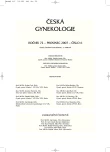Elective Single Embryo Transfer (eSET) - the Way to Decrease the Risk for Multiple Pregnancy
Elective single embryo transfer (eSET) - transfer jednoho embrya - cesta ke snížení rizika vícečetného těhotenství
Cíl:
Podat přehled o studiích a diskusích zabývajících se transferem jednoho embrya s cílem snížení rizika vícečetného těhotenství.
Typ studie:
Rešeršní práce.
Název a sídlo pracoviště:
Centrum asistované reprodukce SANUS, Hradec Králové.
Předmět a metoda rešerše:
Transfer dvou embryí v programu IVF vede často k porodu vícečetného těhotenství (25 %), spojeného se zvýšeným rizikem morbidity pro matku i plody. Studie navrhují realizovat transfer jednoho embrya ve skupině mladých žen (do 36 let), v prvním nebo i druhém cyklu léčby a pouze za předpokladu dostatečného množství kvalitních embryí (více než 4).
Závěr:
Studie prokazují, že strategie transferu jednoho embrya, v současnosti zahrnující transfer jednoho čerstvého embrya, a pokud nedojde k těhotenství, i kryotransfer jednoho embrya, vede k pravděpodobnosti porodu živého plodu srovnatelné s transferem dvou embryí a významně snižuje riziko vícečetného těhotenství.
Klíčová slova:
IVF, eSET, těhotenský index, dvojčetné těhotenství
Authors:
R. Středa
Authors‘ workplace:
Centrum asistované reprodukce SANUS, Hradec Králové, prim. MUDr. J. Štěpán, CSc.
Published in:
Ceska Gynekol 2007; 72(6): 393-396
Category:
Original Article
Overview
Objective:
To present an overview of trials and discussion focused on the method of single embryo transfer leading to reduction of multiple pregnancy rate.
Subject:
Review article.
Setting:
Centre of Assisted Reproduction SANUS, Hradec Králové.
Subject and method:
Transfer of two embryos after IVF results in high multiple birth (25%) associated with increased morbidity for mother and children. Results of randomized controlled trials show that SET offers live birth rate approximately 35% with minimizing the risk of twins. The trials suggest to perform SET in a group of young women (≤ 36 years old), in the first or second cycle and only with sufficient number of good quality embryos.
Conclusions:
Data demonstrates that a single embryo transfer strategy, currently including one fresh single embryo transfer and one addition frozen-thawed SET, results in a live birth rate comparable with double embryo transfer and significantly reduces multiple birth rate.
Key words:
IVF, eSET, pregnancy rate, twins
Labels
Paediatric gynaecology Gynaecology and obstetrics Reproduction medicineArticle was published in
Czech Gynaecology

2007 Issue 6
Most read in this issue
- Pneumonia in Pregnancy
- How Exact Is the Performance of Mediolateral Episiotomy
- Vaginal Bacteriology in Women with Use of Sanitary Towels and Tampons During Menstruation
- Angiomyxoma of the Vulva – a Case Report
